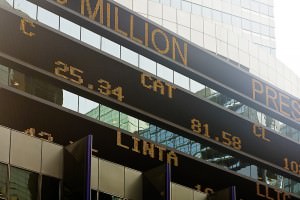Inside the Financial Market Mindset
How emotions and other psychological factors drive it
By: Alexandria Chun, Staff Writer
Financial markets are traditionally thought to be arenas of rational decision-making in which players make calculated investments based on facts and figures. The catch: market players are human. Behind the charts and share prices are people vulnerable to bias and emotion. This is why markets can’t be deemed fully rational institutions. But that’s not to say they’re irrational. Emotions don’t always cause irrationality. In fact, emotions can play a valuable role in successful decision-making.
What roles do emotions play in financial decision-making? Emotions are subconscious responses to events that provide a “summary” of experience. This summary isn’t a synopsis, per se, but rather a feeling that encompasses a person’s impression of the situation at hand. This feeling is also known as intuition.
[pullquote]Humans are naturally loss averse. Be it objects, people, or reputation, losing things generally makes people unhappy.[/pullquote]
A study conducted by London-based psychologists described this rapid decision-making mechanism as “pattern recognition [that] activates emotionally weighted biases which in turn activate stored behavioral repertoires.” In other words, certain situations make us feel and act in certain ways. Contrary to the notion of a rational investor, emotions can be used to facilitate financial decision-making. However, it takes a certain amount of experience to realize which instincts are well-founded, and which are not.
Emotions also play an important role in the social aspect of trading; that is, how the choices of others influence your own. An old saying on Wall Street goes: “It is always warmest inside the herd,” meaning there is security in numbers. For example, in the recent LIBOR scandal, Barclays later reported that it “was under-reporting its rate to avoid the stigma associated with being an outlier with respect to its LIBOR submissions, relative to other participating banks.” Clearly, this wasn’t an entirely rational decision because there were potentially harmful consequences that should have outweighed social pressures. But this concept of not being an “outlier” is one that drives many decisions. On paper, the choice may not be the most appropriate, but if a majority of the group is participating, it’s emotionally difficult to stray from the herd.
On a similar note, if there is a sudden rush to invest in a newly discovered company, it must be promising, right?
Wrong.
It’s true that watching others flock toward an investment opportunity evokes curiosity and even envy. But the latter is a particularly dangerous emotion, as it is spurred by competition and fear of loss. Humans are naturally loss averse. Be it objects, people, or reputation, losing things generally makes people unhappy. Therefore, the possibility of missing out causes some investors to make rash decisions.
This group mentality is common in the finance sector, as seen by the occurrence of asset “bubbles.” Bubbles are periods of excitement that stimulate an influx of investments towards a certain asset. The 2008 real estate bubble and subsequent surge of mortgage-backed securities is one such instance where confidence in a seemingly wonderful asset led to a flood of investments. Unfortunately, in a bubble, the assets themselves are often overvalued by investors, both financially and emotionally. That, plus the social pressures of the market, causes many to buy in. Any information that threatens to disrupt the illusionary bubble is dismissed or rationalized.
[pullquote]…Financial assets are not concrete. Aside from the symbols and numbers, there is no physical substance to them. Their value is simply what the market deems appropriate. [/pullquote]
Bubbles are suitably named because, like real bubbles, they eventually burst. When an asset bubble bursts, it’s not because new information was introduced, but rather the information that was previously swept under the rug can no longer be ignored. Not everyone in 2008 was blind to the fact that derivatives based on subprime mortgages were unstable. But it made people excited, it made people confident, and it made people money.
Clearly, people know asset bubbles exist. So why do they keep happening? Why did the tech bubble of 2000 not teach the lesson that new assets lead to excitement, but not necessarily to returns? Because each time, people are quicker to point a finger than reflect on their own actions. The skewed perception of risk and reward that causes people to fall prey to asset bubbles in the first place also gives rise to anger and blame once the bubble has burst. If blame overshadows guilt in the aftermath of a burst asset bubble, it will only lead to repetition of the behavior. In order to learn, one must feel responsibility for their actions.
So now that we’ve looked at how emotions affect decisions on financial assets, we should also look at how the financial assets themselves affect emotions. As psychologist David Tuckett outlines in his paper “Addressing the Psychology of Financial Markets,” there are three main characteristics of financial assets that have a profound effect on human cognition.
First, financial assets are not concrete. Aside from the symbols and numbers, there is no physical substance to them. Their value is simply what the market deems appropriate. They are not like consumer goods in the sense that you purchase an item with intrinsic value once, and that’s the end of it. In order to buy and hold a financial asset, you must “commit to a dependent relationship of risk and reward.” Each decision to hold the asset is not unlike the one made to initially buy it. As renowned economist John Maynard Keynes once argued, making a long-term investment requires a certain amount of emotional investment known as a “leap of faith.” Without this leap of faith, you may not have a strong enough conviction to hold onto the asset if it underperforms. People who trade without this conviction often regret their decision and sell prematurely. This type of impulsive trading is expensive. Therefore, the abstract nature of financial assets requires both rational and emotional consideration.
This “leap of faith” concept can be illustrated by Facebook’s first day of trading. On May 18, Facebook’s long-anticipated shares became available for trade. This was a promising investment opportunity based on a very popular and solid company. However, on that first day, shares of Facebook traded barely above its IPO price. Was it because there was breaking news that the company was financially unstable? Or was a corporate scandal uncovered that prompted investors to distance themselves? No. It was because people lacked conviction and shied away from investing in an overvalued asset. And to make matter worse, problems with trading mechanisms and uncertainty about trade orders further stripped confidence from investors. All the excitement prior to that day was just hype, and hype isn’t enough to compensate for the insecurity generated by overvaluation.
The second characteristic of financial assets is that they’re volatile, especially when it comes to stocks. This is because there are countless global influences on the values of these assets. As previously mentioned, the markets are run by humans, and thus exposed to human caprice. When bad news is released, shareholders lose confidence and rush to sell what they can, even if doing so will further weaken confidence and drive prices lower. Logically, this does not make sense. Unless there is a guarantee of imminent failure, investors should hold out and minimize the damage, or at the very least not trigger a collapse. But that’s like telling someone it’s okay to stay in a pool full of sharks that have been proven to be harmless. In a perceivably risky situation, emotion wins over logic.
[pullquote]Emotions, intuition, social pressures, and the volatile, abstract nature of financial assets all contribute to the context of financial decision-making. [/pullquote]
Take, for example, the UK bank Northern Rock. During the financial crisis of 2008, many banks were undercapitalized due to a global slowdown in the markets, and so many banks, including Northern Rock, had to take loans from the government. This was not because they were financially in trouble. It was merely an issue of not having enough liquidity. However, in September 2008, when news broke that Northern Rock was taking a £3 billion loan from the Bank of England, share prices plummeted by 32 per cent, causing more grief for the bank. This loss of confidence caused by a misplaced sense of risk led to a dip in share prices that snowballed into a further loss of confidence and capital. What investors should realize is that volatility is a natural byproduct of diverse decisions, and should not be a panic-inducing factor.
And finally, experiences based on financial assets are hard to learn from. The problem is that the outcomes of financial decisions are very context-dependent. The same action could produce very different results depending upon the investor, what they are investing in, and what else is happening in the world at the time of the investment. John Paulson of the hedge fund Paulson and Co. stated in a Bloomberg Businessweek interview that his firm “became overconfident as to the direction of the economy and took a lot of risk.” His firm had been using the more aggressive hedge fund strategies on which they had built their success, but the global climate prevented these strategies from working out as they had in the past. Factors such as the crisis in Europe and lack of economic rebound are part of the context in which these decisions were made. It just goes to show that context is very important, but also very problematic.
So with the psychological effects of financial assets and emotions in mind, is it even possible to make calculated trades? Yes – if you incorporate emotions into the equation. Emotions can be advantageous in making financial decisions if they are understood and regulated. Emotional regulation is an approach used by many successful, well-paid traders. A study of London traders shows that the most successful ones allow themselves to be guided by their intuition. If they get a good or bad feeling about a trade, they analyze what makes them feel that way and look at factual information to verify if their hunches are well-founded. This may seem like an easy thing to do, but this study also found that low experience traders often say they can exercise this skill, but fail to do so when the time comes. Emotional regulation? Easier said than done, especially if the trader is at the beginning of his or her career and hasn’t experienced many losses yet. These early negative experiences prove to have a detrimental effect on traders and their subsequent trades. A method often used by low experience traders to handle emotions is to back away from the situation and revisit it after the emotion has passed. Avoidance like this hinders a trader’s ability to grow and become more experienced.
There’s a myriad of reasons why financial decisions are not as rational as they ought to be. Even in a fairly theory-based environment such as the financial market, the intangible aspects of the human mind are greatly influential. Emotions, intuition, social pressures, and the volatile, abstract nature of financial assets all contribute to the context of financial decision-making. However, there are ways to harness the power of emotions, and if the psychological aspects of the market are understood well enough, it places more power in the hands of the informed investor.
Sources:
The New York Times
CBS News
BBC
Shibashake (Hubpages)
;
ARB Team
Arbitrage Magazine
Business News with BITE.
Liked this article? Hated it? Comment below and share your opinions with other ARB readers!

































Share the post "Inside the Financial Market Mindset"